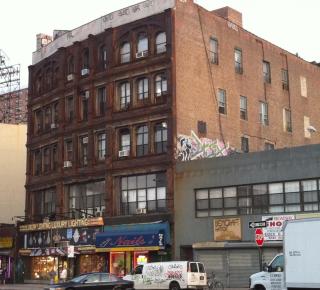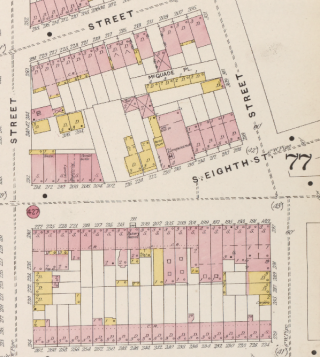In the late 19th century, Theobald Engelhardt was North Brooklyn’s most prolific architect. He designed hundreds of buildings, from small wood-frame tenements to massive factories to grand institutional structures, many of them for Williamsburg’s and Bushwick’s German-American community. And, as it turns out, at least one cast-iron building.
240-246 Broadway sits on the south side of Broadway, just west of Havemeyer Street. If you’re riding on the J, M, Z to Manhattan, you pass right in front of it as the subway veers away from Broadway towards the Williamsburg Bridge. The eastern half of the building actually fronts onto South 8th Street, where that street merges with Broadway. The slight splay of the two streets gives the building’s façade a curved aspect, though it is really angled just slightly.
The building is one of four surviving cast-iron buildings on Wiliamsburg’s lower Broadway (the other three being the Sparrow Shoelast Factory (William Ditmars, 1882), the first Smith-Gray Building at 103 Broadway (William H. Gaylor, 1870) and the second Smith-Gray Building at the corner of Bedford and Broadway (Gaylor, 1881). These buildings were part of Williamsburg’s commercial core, originally centered on the Broadway ferry and which was anchored by a series of banks of insurance companies (and was the metropolitan area’s largest concentration of financial institutions outside of lower Manhattan).
240 Broadway was constructed in 1891 for Louis Zechiel of 212 South 8th Street1 . The builders are listed as W. J. Moran (of South 5th Street 2 ) and J. Wagner, Jr. Zechiel was born in Baden Germany in 1826, and a young man apprenticed in the fur trade 3 . He emigrated to Brooklyn in 1848, where he became a prominent figure in Williamsburg’s German-American community. Among other civic involvements, Zechiel was a founding member and first president of the Arion Singing Society 4 and the Vice President of Germania Savings Bank 5 .
Zechiel continued in the fur industry, becoming a successful fur manufacturer who for many years had his store on Broadway near Union Avenue. Zechiel’s specialty within the fur business was sleigh robes (the 1880 U. S. Census lists his occupation as “fancy furs and sleigh robes”). He established his firm in 1856 6 and was active in the business until 1880, when he passed the day-to-day operations over to his eldest son, William 7 .
William Zecihel ran the business until 1898, when, presumably, the demand for sleigh robes was on the wane. (Fur Trade Review in 1897 reports that William continues to manufacture “high-class sleigh robes” and “a full assortment of driving goods”, but elsewhere in the same issue notes that he will close the business the following April.)
In addition to Zechiel’s fur manufactory and showrooms, 240 Broadway was home to a host of other manufacturing businesses. The 1897 Lain’s directory lists C. W. Loomis & Son neckwear, Troutman & Co., a pants manufacturer, Thomas McGovern’s undertakers’ supplies, and two different upholstery goods manufacturers. At that time, the ground floor storefronts contained a barber and a shoemaker.
With the opening of the Williamsburg Bridge in 1903, the context of 240 Broadway underwent a significant change. As seen in the 1887 Sanborn map of Brooklyn, this block of Broadway was a typical urban block, with a full blockfront of brick commercial buildings directly across the street. Upon the completion of the bridge, the two blocks to the north of 240 Broadway were cleared for the creation of Williamsburg Bridge Plaza. Following the creation of the plaza, many of the banks and businesses that were formerly located near the ferries at the base of Broadway and Grand Street established new headquarters around the plaza.
The opening of Williamsburg Bridge Plaza seems to have had some impact on the tenancy of 240 Broadway. By the time of World War I, the shoe and clothing manufacturers in the loft building were joined by offices for a Liberty Loan committee, a branch of the American Red Cross and a branch office recruiting factory workers for the Loose-Wills and Sunshine biscuit factories in Long Island City.
- 1Record and Guide, May 9, 1891, 766.
- 2Lain’s Directory, 1897
- 3Belden, Albert Lord, The Fur Trade of America, (New York: Peltries Publishing Co., 1917),
- 4”The Arion Ball”, Brooklyn Daily Eagle, February 22, 1888, 1
- 5Brooklyn Daily Eagle, April 1, 1887, 3
- 6Fur Trade Review, vol 14, 1897, p. 306
- 7”Obituary”, Brooklyn Daily Eagle, August 25, 1895, 6

